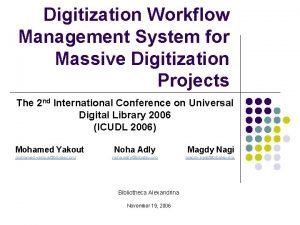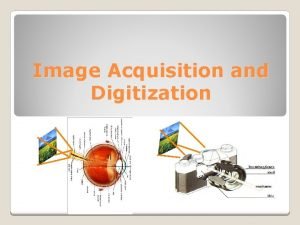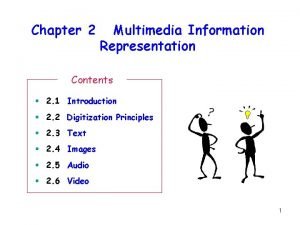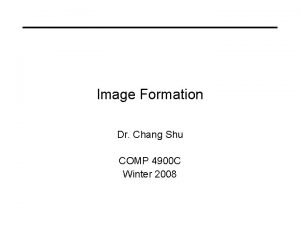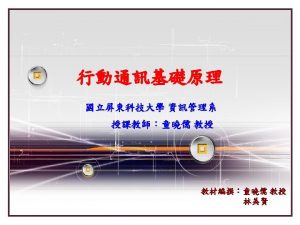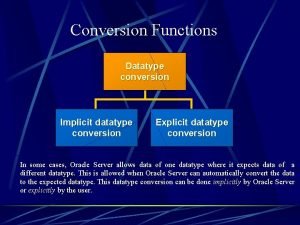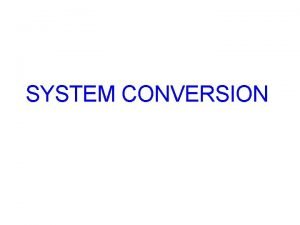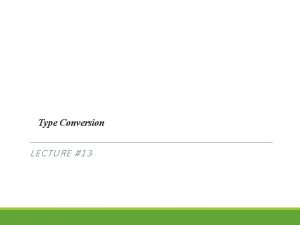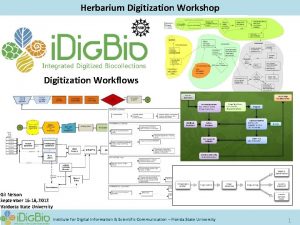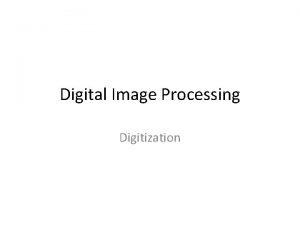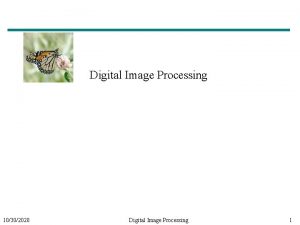Digitization AD and DA Conversion Digital Processing w





















- Slides: 21

Digitization - A/D and D/A Conversion

Digital Processing w w w The two analog filters are used to avoid aliasing at the input and to smooth the output. They both have analog input and output The digital processor has a digital input and a digital output The ADC and DAC are hybrid devices : w The ADC has analog input and digital output w The DAC has digital input and analog output


Amplitude Sampling 2 1. 8 1. 6 1. 4 1. 2 1 0. 8 0. 6 0. 4 0. 2 0 w Take snapshots of continuously changing data w The Sampling Period is fixed w This makes information understandable 1 2 3 4 5 6 7 8 9 10 11 12 13 14 TIME (in Seconds) Sampling Period – The period between samples Sampling Time (The Snapshot) – The time taken to take a sample



Amplitude Missing Information – Improper Sampling 1. 4 1. 2 1 0. 8 0. 6 0. 4 0. 2 0 w Non-periodic sampling PBUY May miss information The dip between T 3 and T 4 goes unnoticed TIME T 1 T 2 Amplitude w T 3 T 4 T 5 T 6 1. 4 1. 2 1 0. 8 0. 6 0. 4 0. 2 0 w Information cannot be interpreted easily w Periodic sampling PBUY w May miss information The dip between T 2 and T 3 goes unnoticed TIME T 1 T 2 T 3 Actual variation Inferred plot T 4 w Easier to interpret The key is the sampling frequency.

Getting the Sampling Right TIME FREQUENCY |A| fs- fa fs+ fa |A| CASE 1 t fs>>fa fs = Sampling Frequency fa = Signal Frequency |A| CASE 2 t fa fs 2 fs f |A| fs=2 fa fa fs 2 fs f |A| t CASE 3 Inferred Signal fs<2 fa fs Alias Original Signal fa f

Aliasing due to Improper Sampling w Top: the analog signal and spectrum w Middle: Sampling, if done properly, allows error-free reconstruction of the analog signal from its samples w Bottom: if sampling rate is lower than twice the largest frequency in the signal, aliasing occurs.

Limiting the Spectrum |A| fs fm fs f w Frequency components greater than ½fs cause aliasing (f>fm) w Get rid of (filter out) frequencies above fm (no aliasing) w Then ensure that the sampling rate is greater than 2 fm Aliasing |A| fs>2 fm fm f



Quantizing the Signal |A| sample & ts 4 ts hold t 8 ts |A| w Aim is to limit the representation of each sample to a finite set of values – to quantize each sample w The set of quantization levels is the values representable in the digital processor w More levels means more accuracy, and smaller rounding error 11 10 01 00 ts |A| 4 ts 8 ts quantize ? ? ? t 11 10 01 Signal = 10 10 01 01 00 00 01 00 ts 4 ts 8 ts t

Digitizing the Signal w Digitization has two stages: of sampling and quantization w Sampling, if done properly, may be error-free w Quantization entails an error of half LSB ( ) w The distribution of quantization error is assumed uniform

Quantization Error |A| w Quantization introduces errors Quantization Error w Increasing the number of t |A| quantization levels is not always the answer to reducing error w Non-uniform Quantization w Use more levels where there are more variations w Use fewer levels where there are t fewer variations

Quantization Error w Quantization error for a sinusoidal signal (in blue) w Quantization error for an audio signal (in blue)

A Short reminder on Digitization Errors w Niquist sampling theorem states that we can sample a w w signal without losing information if we sample at twice the highest frequency in the signal Real A/D converters introduce quantization noise. This noise is commonly of uniform distribution, and is white - spreading throughout the frequency range. The quantization noise is reduced at about 6 d. B per bit w -48 d. B @ 8 bit w -72 d. B @ 12 bit w -96 d. B @ 16 bit

Types of A/D Converters w There are several types of A/D converters. Among the main ones are: w The fast Flash ADC w The slow Successive Approximation ADC w Pipelined ADC w The Sigma-Delta ADC

Smoothing the Output DAC 010001 DIGITAL IN LOWPASS FILTER SAMPLE AND HOLD |A| SMOOTHED OUTPUT |A| t t w Convert digital input to analog value w Hold until the next digital input is converted w Finally, smooth the output signal

Commercial Converters AIC 23 ANALOG IN ANALOG OUT ANTIALIASING FILTER RECONSTRUCTION FILTER ADC DAC SERIAL PORT Analog Interface Circuit (AIC) SERIAL DIGITAL OUT w ADC and DAC on same chip (Sigma Delta) w 16 bit digitized data serialized (ADC & DAC) w Interfaces to serial port of DSP w Programmable Antialiasing filter w Programmable Reconstruction filter (Smoothing Filter)

C 6713 DSK Design USB PC w w CTRL D 0–D 31 A 0–A 31 SERIAL PORT TMS 320 C 6713 AIC 23 ’C 6713, 32 -Bit Floating Point DSP w w 4 K x 32 Bits On-Chip Data Cache 128 K x 32 Bits On-Chip L 2 Cache 6 ns Single-Cycle Instruction Execution Time Analog Interface Unit (AIC) Contains w w w ADC (16 -bit) DAC (16 -bit) Filters w Parallel Port w JTAG and Expansion Connector ANALOG OUT ANALOG IN
 Histogram processing in digital image processing
Histogram processing in digital image processing Point processing and neighbourhood processing
Point processing and neighbourhood processing Neighborhood processing in digital image processing
Neighborhood processing in digital image processing Point processing
Point processing Point processing in digital image processing
Point processing in digital image processing Thinning and thickening in image processing example
Thinning and thickening in image processing example Speech digitization and generation in hci
Speech digitization and generation in hci Project management and workflow for digitization projects
Project management and workflow for digitization projects Image sensing and acquisition
Image sensing and acquisition Voice digitization
Voice digitization Digitization of sound in multimedia
Digitization of sound in multimedia Global trade digitization
Global trade digitization Introduction to digitization
Introduction to digitization Cp.4k786.com
Cp.4k786.com Afres full form in railway
Afres full form in railway Digitization workflow diagram
Digitization workflow diagram Digitization grants
Digitization grants Comp4900
Comp4900 Ddo template 4
Ddo template 4 Difference between primary and secondary processing
Difference between primary and secondary processing What is interactive processing
What is interactive processing Digital to analog conversion in data communication
Digital to analog conversion in data communication







